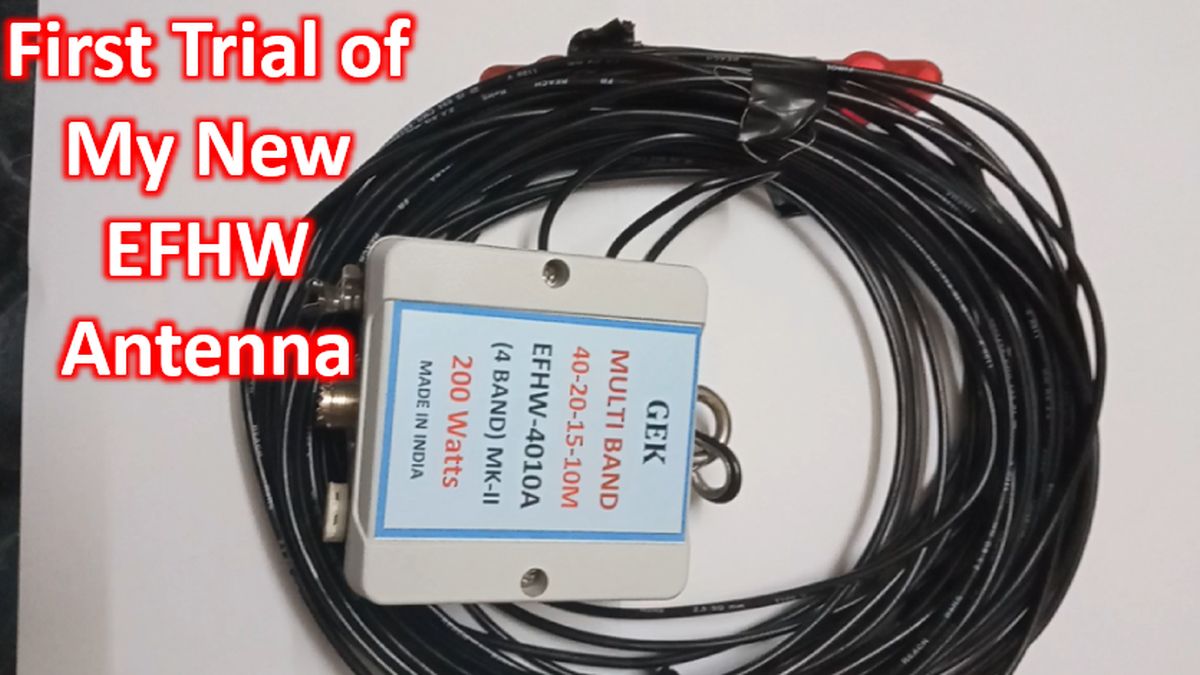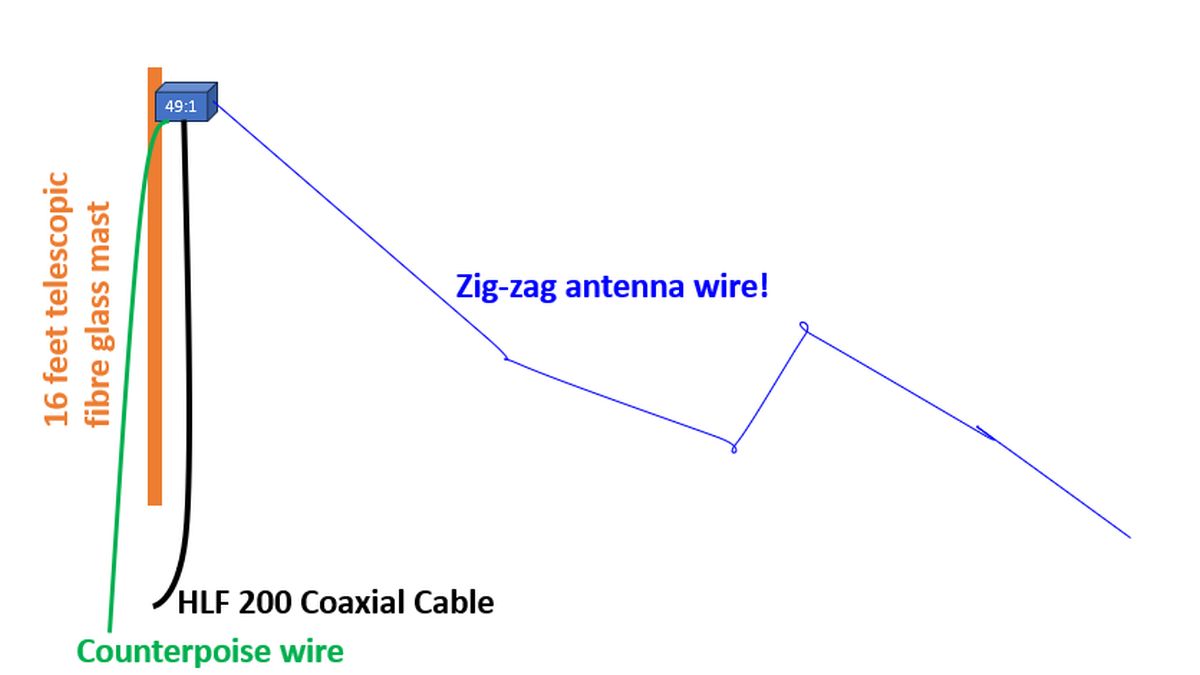First Trial of My New EFHW Antenna
Through out my nearly four decades of Ham Radio, I have never used an End Fed Half Wave Antenna. As it is difficult to route multiple coaxial cables into my shack, I thought that Multi-Band EFHW is the only way to go for multiple bands. I been using a modified inverted V antenna for 40 m and an inverted V dipole antenna for 20 m for the past two months or so. Though I had used a dual band fan dipole for 40 and 20 m in between, I was not very happy with it. Bought an EFHW for 40, 20, 15 and 10 m from another ham. The antenna length was mentioned as 20 m, which was half wave at the lowest frequency. It would resonate for higher harmonic ham bands without an antenna tuner.

There was a 49:1 balun at the feedpoint. It has an SO 239 connector for the antenna coaxial cable. Another connector is there for the counterpoise wire.
Opposite side has a stainless steel anchoring hook for one end of the antenna wire. There is also a protective stainless steel sheath for the antenna wire hooked over it. The hook can be used to tie the balun to the mast.
A nice insulator can be seen at the end of the antenna wire, which can be used to anchor it using a nylon rope. Antenna wire can be seen twisted on itself for a short length at that end.
This an inner view of the 49:1 balun wound on a FT 240-43 toroidal core. Connections to the inner and outer condutors of the SO 239 connector can be seen on one side. On the other side connection to the antenna wire is visible. Central conductor of SO 239 is also connected to a capacitor, the other end of which is connected to the counterpoise wire connector.
Started off by connecting a surplus 2.5 sq mm insulated copper wire to the connector for the counterpoise. Both the coiled counterpoise wire and antenna wire can be seen here. Though counterpoise has not been recommended if the balun is installed high above the ground, I am planning to use one for my initial trial as I am concerned about the unbalanced current on the outer surface of the coax with EFHW. If balun is installed high above the ground, all that has been recommended by the provider is to ground the coax outer shield at entry to the shack or at the radio. For this initial trial I am planning to connect the counterpoise wire to the ground rod just outside my shack.
This is the telescopic fibre glass pole which I am using to elevate the balun end of the EFHW. It is 8 feet long in the shortened mode and can be lengthened up to 24 feet. Due to a technical snag or unfamiliarity of this device, I could lengthen only one of the two telescopic sections. So I presume that the height will be only 16 feet instead of the intended 24 feet, for the initial trial. For the same reason, I had to use four anchoring ties for the antenna wire at multiple levels to have it fit in the limited space above my balcony and garden.

The antenna ended up more zig-zag than I had intended. May be after the initial trial, I will try to raise it to the expected 24 feet level so that the antenna wire can be straightened a bit more, though not fully. Current installation is as sloper with balun at highest point and opposite end about 7 feet from the ground. This is the approximate sketch of the antenna, though it is not according to scale.
Tried the Silicon City Net at 4.45 pm on 7088 kHz and found it quite noisy. Checked with a couple of stations working on 7070 kHz and got 5,6 report from a station about 35 km away and 5,4 report from another at 205 km, both towards the South. It was clearly worse than my modified 40 m inverted V. But the inverted V was about 1 m higher and the antenna wire much straighter, though the highest point was not at the feedpoint. As I had to dismantle it for installing the EFHW, I could not make a direct comparison on the same band conditions.
Though the initial performance on 40 m made me unhappy, 20 m performance was good. I could get a 5,9+5 dB report from a station to the North at 1150 km, at Nagpur, 17.3° NNE from here. The contact was quite comfortable from both ends.
Next I moved on to 10 m on which band I have never been able to hear any station using my 20 m and 40 inverted V dipole antennas. I heard A41NN at 2282.2 km, 308.8° NW, calling CQ and was quite strong. The band noise was much lesser than on 20 m and 40 m. I got an immediate reply to my call and a 5,5 report. I was quite happy to have my first contact on 28 MHz, that too a DX station.
I am planning to increase the height of the antenna and make some changes in the zig-zag configuration to straighten the antenna wire a bit more. I will try a free hanging counterpoise as otherwise I will have to lengthen the wire by adding an additional piece. I have kept a few turns of extra HLF 200 coax as an ‘RF choke’ tied to the mast, which will also go away if I am able to elevate the mast. I had used two 10 m cables with pre-crimped PL 259 connectors at both ends and connected to each other using an SO 239 barrel connector. So total cable length is 20 m, the same which was being used for my modified inverted V 40 antenna which had to be dismantled for putting up this antenna.
Tested 40 m once again today morning at 7.25 am. Reports were still poor and the radio got hung up for a short period, which my friend suggested as probably due to RF return from the antenna. But the tuned SWR was still nearly 1:1. So I stopped further tests on 40 m and decided to have another look at my antenna layout in an attempt to improve 40 m performance. As suggested by my friends on the air, I will go step by step testing the SWR without the built-in tuner, using the external SWR meter. That was how I went about with my inverted V dipole antennas. This time I skipped that step as this EFHW was delivered after testing. But there are a lot of compromises in my setup due to space constraints in the compound.